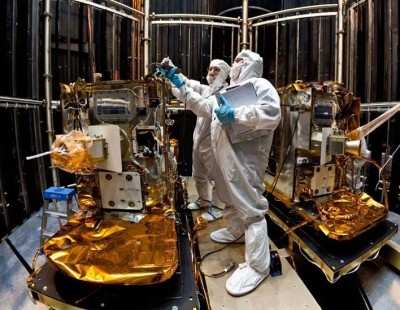Sat, Dec 31, 2011
GRAIL-A Just Hours Away, GRAIL-B Close Behind
NASA's unmanned programs are celebrating the end of 2011 with a
return to the Moon. NASA's Gravity Recovery And Interior Laboratory
(GRAIL)-A spacecraft is within a few hours of its insertion burn
that will place it into lunar orbit.

At the time the spacecraft crossed the milestone at 1:21 p.m.
PST Friday (4:21 p.m. EST), the spacecraft was 30,758 miles from
the moon. Launched aboard the same rocket on Sept. 10, 2011,
GRAIL-A's mirror twin, GRAIL-B, is also closing the gap between
itself and the moon. GRAIL-B is scheduled to perform its lunar
orbit insertion burn on New Year's Day (Jan. 1) at 2:05 p.m. PST
(5:05 p.m. EST).
As they close in on the moon, both orbiters move toward the moon
from the south, flying nearly directly over the lunar south pole.
The lunar orbit insertion burn for GRAIL-A will take approximately
40 minutes to complete and change the spacecraft's velocity by
about 427 mph. GRAIL-B's insertion burn - occurring 25 hours later
-- will last about 39 minutes and is expected to change its
velocity by 430 mph.
The insertion maneuvers will place each orbiter into a near-polar,
elliptical orbit with an orbital period of 11.5 hours. Over the
following weeks, the GRAIL team will execute a series of burns with
each spacecraft to reduce their period down to just under two
hours. At the start of the science phase in March 2012, the two
GRAILs will be in a near-polar, near-circular orbit with an
altitude of about 34 miles.

During the science phase, the moon will rotate three times
underneath the GRAIL orbit. The collection of gravity data over one
complete rotation (27.3 days) is referred to as a Mapping Cycle.
When science collection begins, the spacecraft will transmit radio
signals precisely defining the distance between them as they orbit
the moon in formation. Regional gravitational differences on the
moon are expected to expand and contract that distance. GRAIL
scientists will use these accurate measurements to define the
moon's gravity field. The data will allow mission scientists to
understand what goes on below the surface of our natural satellite.
This information will help us learn more about how the moon, Earth
and other terrestrial planets formed.
NASA's Jet Propulsion Laboratory, Pasadena, Calif., manages the
GRAIL mission. The Massachusetts Institute of Technology,
Cambridge, is home to the mission's principal investigator, Maria
Zuber. The GRAIL mission is part of the Discovery Program managed
at NASA's Marshall Space Flight Center in Huntsville, Ala. Lockheed
Martin Space Systems, Denver, built the spacecraft. JPL is a
division of the California Institute of Technology in Pasadena.
More News
Airbus Racer Demonstrator Makes Inaugural Flight Airbus Helicopters' ambitious Racer demonstrator has achieved its inaugural flight as part of the Clean Sky 2 initiative, a corners>[...]
A little Bit Quieter, Said Testers, But in the End it's Still a DA40 Diamond Aircraft recently completed a little pilot project with Lufthansa Aviation Training, putting a pair of >[...]
Line Up And Wait (LUAW) Used by ATC to inform a pilot to taxi onto the departure runway to line up and wait. It is not authorization for takeoff. It is used when takeoff clearance >[...]
Contributing To The Accident Was The Pilot’s Use Of Methamphetamine... Analysis: The pilot departed on a local flight to perform low-altitude maneuvers in a nearby desert val>[...]
From 2015 (YouTube Version): Overcoming Obstacles To Achieve Their Dreams… At EAA AirVenture 2015, FedEx arrived with one of their Airbus freight-hauling aircraft and placed>[...]
 Airbus Racer Helicopter Demonstrator First Flight Part of Clean Sky 2 Initiative
Airbus Racer Helicopter Demonstrator First Flight Part of Clean Sky 2 Initiative Diamond's Electric DA40 Finds Fans at Dübendorf
Diamond's Electric DA40 Finds Fans at Dübendorf ANN's Daily Aero-Term (04.23.24): Line Up And Wait (LUAW)
ANN's Daily Aero-Term (04.23.24): Line Up And Wait (LUAW) NTSB Final Report: Extra Flugzeugbau GMBH EA300/L
NTSB Final Report: Extra Flugzeugbau GMBH EA300/L Classic Aero-TV: 'Never Give Up' - Advice From Two of FedEx's Female Captains
Classic Aero-TV: 'Never Give Up' - Advice From Two of FedEx's Female Captains




